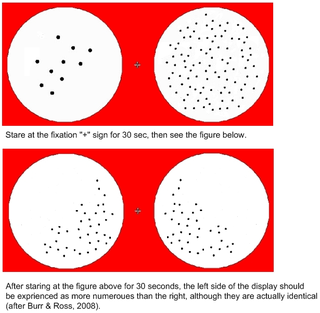Numerosity_adaptation_effect
Numerosity adaptation effect
Phenomenon in numerical cognition
The numerosity adaptation effect is a perceptual phenomenon in numerical cognition which demonstrates non-symbolic numerical intuition and exemplifies how numerical percepts can impose themselves upon the human brain automatically. This effect was first described in 2008.[1][2]

Presently, this effect is described only for controlled experimental conditions. In the illustration, a viewer should have a strong impression that the left display (lower figure) is more numerous than the right, after 30 seconds of viewing the adaptation (upper figure), although both have exactly the same number of dots. The viewer might also underestimate the number of dots presented in the display.[1]
Both effects are resistant to manipulation of the non-numerical parameters of the display. Thus, this effect cannot be simply explained in terms of size, density, or contrast.[3][4]
Perhaps the most astonishing aspect of these effects is that they happen immediately, and without conscious control (i.e., knowing that the numbers are equal would not hamper their happening).[1] This points to the operation of a special and largely automatic processing system. As noted by Burr & Ross (2008):
Just as we have a direct visual sense of the reddishness of half a dozen ripe cherries, so we do of their sixishness.[2]